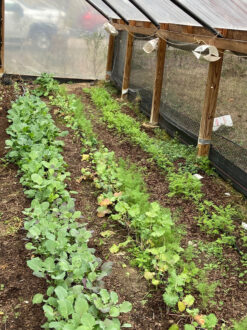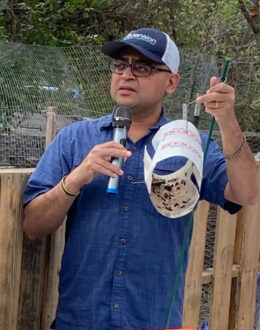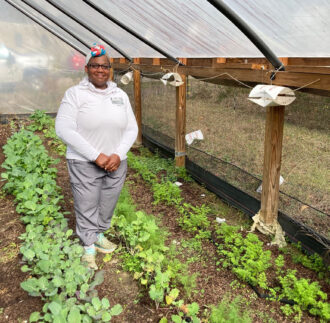DOTHAN, Alabama – Vegetable producer Sheena Bain, of Bain Home Gardens, sees the black woven shade cloth permanently installed on her high tunnel as a game changer in controlling a whole host of crop pests.
“We’ve had success in managing pests in the high tunnel that we normally would not have, compared to the level of pests we’ve seen in our open fields,” said Bain.
The small urban farmer isn’t the only producer across Alabama who has effectively managed pests in high tunnels through High Tunnel Pest Exclusion (HTPE) – a system that combines woven shade cloth with Integrated Pest Management (IPM) practices. Bain Home Gardens was recently the site of an Alabama Cooperative Extension System high tunnel workshop that demonstrated the technology with area farmers and ag professionals.
HTPE consists of a woven netting that is permanently installed under the side walls of a high tunnel with the intention of preventing pest establishment within the high tunnel. It’s generally combined with other practices, such as the release of beneficial insects, insect monitoring traps, and limited use of bioinsecticides, for an overall IPM strategy of creating a pest barrier.

Alabama Cooperative Extension entomology and plant pathology professor Ayanava Majumdar has been studying the impact of HTPE on a host of insect pests in high tunnel production since 2014. He said that HTPE is effective in controlling macro-pests, such as loopers, squash vine borer, tomato hornworm, armyworms, fruitworms, leaf-footed bugs and stink bugs.
On-farm participatory research and demonstrations conducted at 22 farms across Alabama from 2017-2021 found 72 percent to 100 percent of those pests excluded from high tunnels with a 50 percent shade cloth depending on the moth size. For example, hornworm moths cannot get in and are completely excluded from a netted tunnel.
“We’ve found that a 40 percent-50 percent woven shade cloth is just perfect in keeping those bigger pests out of the high tunnel and just small enough for some beneficial insects like lady beetles to sneak through,” said Majumdar. “Why the black color? It’s simply the cheapest material to go with and easily available from local vendors.”
The study was part of a larger pest management project using HTPE funded by the Southern Sustainable Agriculture Research and Education (SSARE) program.

Majumdar said that larger beneficial insects, such as lacewings and the praying mantis, won’t be able to fit through the woven shade cloth. “Farmers will have to release them inside the high tunnel, and the good thing about that is they can’t get out. You are forcing those natural predators to feed inside,” said Majumdar. “Smaller pests like aphids and whiteflies will be able to get into the high tunnel, so keeping those natural predators inside is a good thing.”
Pollinators, such as bumblebees, will also not be able to get into the high tunnel to pollinate vegetable crops, so placing bumblebee boxes inside the high tunnel is also a good strategy, said Majumdar.
Installing pest monitoring traps around the outside of the high tunnel, as well as along the inside edges, and applying bioinsecticides as necessary, helps round out an effective pest management strategy, said Majumdar. Installing netting when transitioning crops with sanitation practices adds to overall pest reduction.
“Pest prevention is better than the cure,” he said.
For more information on the HTPE system, visit the following resources:
SARE Pest Management: High Tunnels and Other Season Extension Techniques
